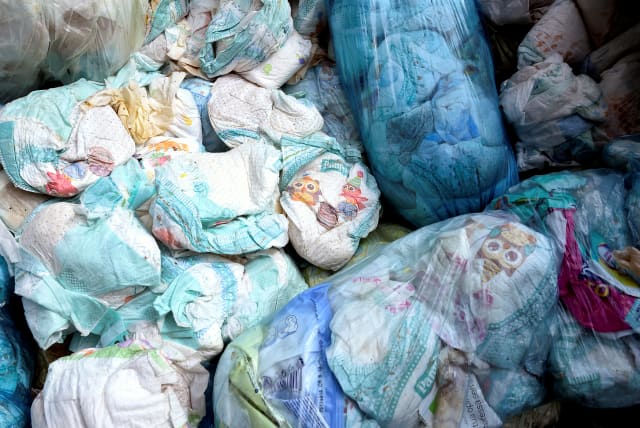Dirty diapers: An environmental hazard or potential construction material? - study

Japanese scientists have found that up to 8% of the sand in concrete and mortar used to make a single-story house could be replaced with shredded used disposable diapers.
Disposable diapers manufactured from wood pulp, cotton, viscose rayon, and plastics such as polyester, polyethylene and polypropylene make a major “contribution” to garbage around the world that has to be burnt or buried in landfill.
In Israel, with its high birthrate, dirty diapers form mountains in garbage dumps.
What can be done about them polluting the land and the air around the world? Japanese scientists have found that up to 8% of the sand in concrete and mortar used to make a single-story house could be replaced with shredded used disposable diapers without significantly diminishing their strength, according to a study published in Scientific Reports.
The authors, whose article was entitled “Application of non-degradable waste as building material for low-cost housing,” suggest that disposable diaper waste could be used as a construction material for low-cost housing in low- and middle-income countries.
Can dirty diapers be used to build homes?
“The high costs of two crucial inputs of land and building materials are a fundamental reason housing needs to be more attainable for the urban poor. Building materials are often the single most considerable tangible input into the construction of housing and can account for up to 80% of the overall worth of a simple residential dwelling. It leads to the cost factor becoming the first barrier to sustainable construction,” they wrote.
If the price of building materials doubles in contrast to the median price of other commodities, the length of time that a household will be required to work to afford the price of building materials will also nearly double, but many governments, both central and municipal, continue to insist on using conventional building materials and techniques. The various building rules and regulations mandate these, the majority of which are either a holdover from the days of colonialism or were imported from other nations, they continued.
“These restrictions and standards prevent using building materials that are more appropriate and readily available in the local area. Additionally, these prevent the use of construction technologies that are both cost-effective and environmentally friendly.”
Siswanti Zuraida, a doctoral student in engineering and colleagues at Japan’s University of Kitakyushu, prepared concrete and mortar samples by combining washed, dried, and shredded disposable diaper waste with cement, sand, gravel and water. The samples were then cured for 28 days. They tested six samples containing different proportions of diaper waste to measure how much pressure they could withstand without breaking and then calculated the maximum proportion of sand that could be replaced with disposable diapers in a range of building materials that would be needed to construct a house with a floorplan area of 36 square meters that complies with Indonesian building standards.
The authors found that disposable diaper waste could replace up to ten percent of the sand needed for concrete used to form columns and beams in a three-story house. This proportion increased to 27% of sand needed for concrete columns and beams in a single-story house. Up to 40% of the sand needed for mortar in partition walls can be replaced with disposable diapers, compared to 9% of the sand in mortar for floors and garden paving. Together, up to 8% of the sand in all of the concrete and mortar building materials required to build a single-story house with a floorplan of 36 square meters can be replaced with disposable diaper waste – equivalent to 1.7 cubic meters of waste.
The authors suggest that wider implementation of their findings would require the involvement of stakeholders in government and waste treatment in developing processes for the large-scale collection, sanitizing and shredding of diaper waste. Building regulations would also need to be modified to allow the use of diaper waste as a construction material.
Jerusalem Post Store
`; document.getElementById("linkPremium").innerHTML = cont; var divWithLink = document.getElementById("premium-link"); if (divWithLink !== null && divWithLink !== 'undefined') { divWithLink.style.border = "solid 1px #cb0f3e"; divWithLink.style.textAlign = "center"; divWithLink.style.marginBottom = "15px"; divWithLink.style.marginTop = "15px"; divWithLink.style.width = "100%"; divWithLink.style.backgroundColor = "#122952"; divWithLink.style.color = "#ffffff"; divWithLink.style.lineHeight = "1.5"; } } (function (v, i) { });


